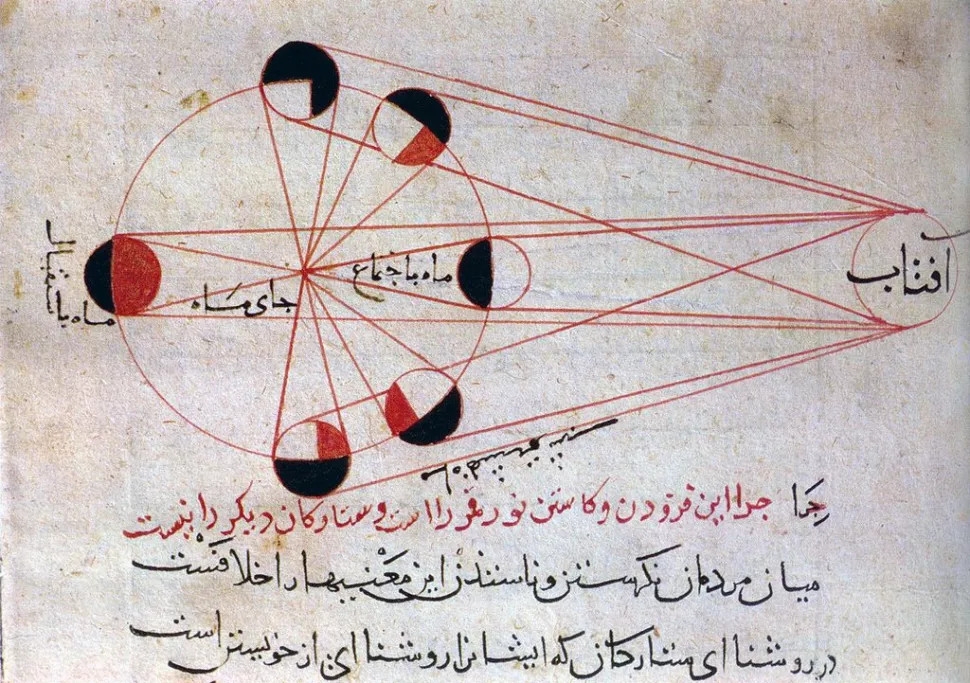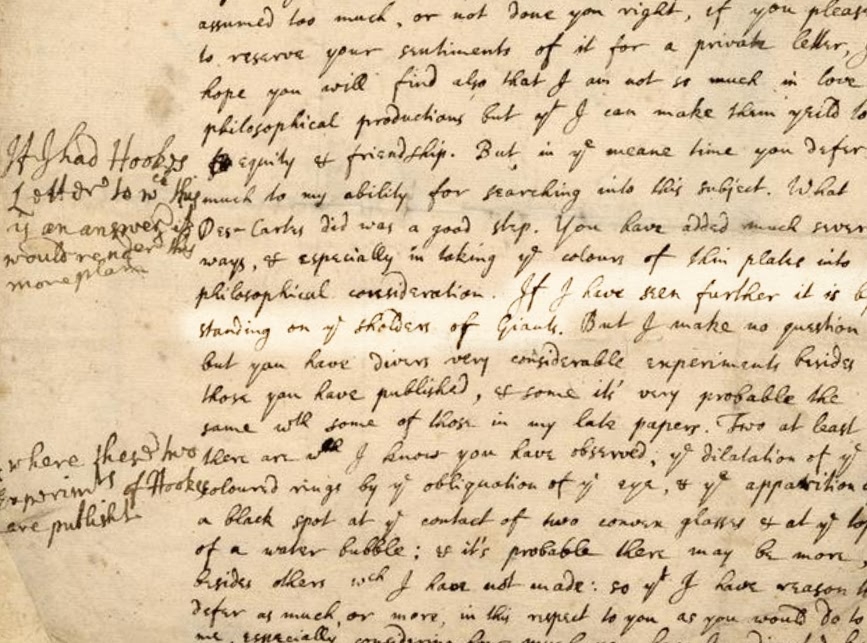
A sketch of the phases of the moon by Persian astronomer Al-Biruni, who worked during the Islamic Golden Age (Public Domain Image).
Image Source: Space.com ; Title: Phases of the Moon, Depicted in the Islamic Golden Age;
Isaac Newton is a central figure in physics. A simple search of his name in the Niels Bohr Library & Archives (NBLA) book catalog brings up hundreds of titles, including several pieces from the eighteenth century. Although he is well-known and cited for his fundamental contributions to physics and mathematics, Newton himself recognized that he did not work in isolation. In a letter to Robert Hooke, included below, Isaac Newton remarked, "If I have seen further, it is by standing on the shoulders of giants." The sources of information in Newton’s Principia Mathematica were global- including the Americas, the Middle East and India. [1]
Image caption: Portrait of Isaac Newton. Isaac Newton is credited as an independent inventor of calculus. He made foundational contributions in optics and motion and connected sources of natural philosophy from around the world. Image source: ESVA Newton_Isaac_A3. Credit: Original engraving by unknown artist, courtesy of AIP Emilio Segrè Visual Archives.

Letter from Isaac Newton to Robert Hooke. Isaac Newton writes, “If I have seen further, it is by standing on the shoulders of Giants.” Image from HSP Digital Library, and has been cropped and highlighted.
Credit: Historical Society of Pennsylvania. https://discover.hsp.org/Record/dc-9792/Details
One particularly important set of sources for Isaac Newton, as well as many other natural philosophers, was the Middle East. During the Islamic Golden Age (between the 8th and 13th centuries, under Abbasid leadership), Persian, Turkish and Arab scholars preserved and offered commentaries on classical natural philosophy. They also advanced understanding of the natural world, particularly in astronomy.
Scholars from the Islamic Golden Age developed understandings of motion prior to Newton’s three laws of motion, a major topic in introductory physics. While understanding of motion changed between the Islamic Golden Age (8th-13th centuries) and the period that is known as the Scientific Revolution (between Copernicus/1543 and Newton/1678), scholars of the Islamic Golden Age offered significant breaks from the concepts of Aristotelian natural philosophy and paved the way for the Scientific Revolution. Their work was indispensable in the development of Newtonian mechanics.
This can be seen by looking at the development of the law of inertia. Ibn Sīnā developed an early form of the law of inertia, which is given below along with both Newton’s formulation and the modern formulation.
Formulation from the Islamic Golden Age (translated): No [object] begins to move or comes to rest of itself. [2]
Newton’s First Law (translated): Every [object] persists in its state of being at rest or of moving uniformly straight forward, except insofar as it is compelled to change its state by force impressed. [3]
Modern Law of Inertia: In an inertial frame, an object at rest remains at rest and an object at a constant velocity remains at that velocity unless acted upon by a force.
Notably, Ibn Sīnā’s most significant work on natural philosophy, titled The Book of Healing, was likely completed exactly one thousand years ago, in 1020. Despite its title, the work is not medical. The work was named after its goal, which was to cure ignorance. [4]

Depiction of Ibn Sīnā. Persian polymath Ibn Sīnā was an early contributor to the law of inertia. (Image Credit: Adam Jones,/Museum at BuAli Sina Mausoleum, CC BY-SA 2.0). Image Source: Wikipedia- Avicenna
The contributions of Ibn Sīnā and other scholars from the Islamic Golden Age are worth recognizing in the history of physics. The Center for Physics of Physics teaching guide “On the Shoulders of Giants: Inertia from Ibn Sīnā to Newton” introduces both the law of inertia and the Islamic Golden Age.
The following timeline highlights select developments pertinent to the history of physics from both the Middle East and Europe to contextualize the work of Ibn Sīnā and his contemporaries.
Access timeline: On the Shoulders of Giants: Inertia from Ibn Sīnā to Newton Timeline
Sources
[1] S. Schaffer, “Newton on the Beach: The Information Order of the Principia Mathematica” Hist. Sci., xlvii (2009).
[2] E. Hecht, Phys. Teach 53, 80 (2015): https://doi.org/10.1119/1.4905802.
[3] I. Newton edited by I.B. Cohen and A. Whitman, Principia Mathematica (University of California Press, Berkeley, 1999).
[4] Wikipedia, “The Book of Healing,” <https://en.wikipedia.org/wiki/The_Book_of_Healing>
Add new comment
Pante
In the timeline you didn't put Galileo Galilei, is there a reason?
Add new comment